Alright, folks. So, picture this: I’m living in a tiny apartment, crammed between a laundromat and a coffee shop, dreaming of a lush garden.
Then, I stumble upon compact fruit trees. Dwarf apple trees? Perfect. Meyer lemon trees in containers? Yes, please! Cherry and peach trees blooming, giving me life (and fruit).
And let’s not forget about those dwarf fig trees that practically grow themselves. Seriously! Imagine a mini orchard bringing beauty to my urban jungle. Isn’t it time we embraced a little greenery?
—
My Garden Design Journey: Transforming Urban Spaces with Nature
Once, I decided to landscape my balcony. Armed with my new found love for compact fruit trees, I transformed this small space into an abundant haven: a Meyer lemon tree gracing one corner, dwarf blueberries lining the rail, and even a cherry tree blooming in a chic pot. The neighbors were envious, and honestly, it felt fantastic! Who knew urban design could blend so beautifully with nature?
I realized that it’s not just about aesthetics; it’s about creating a connection with the fruits of our labor. Garden design is like creating a beautiful tapestry of green in a concrete world, don’t you think? Embrace the chaos of city life, and let nature remind you of life’s simple pleasures.
Quick Takeaways
- Dwarf apple trees are ideal for small spaces, offering sweet fruit and requiring well-drained soil and full sunlight.
- Meyer lemon trees thrive in containers, attracting pollinators with fragrant blossoms and enhancing urban aesthetics.
- Dwarf cherry and peach trees provide beautiful blooms and sweet fruit, needing strategic cross-pollination for optimal harvests.
- Bush blueberries are adaptable to container gardening, perfect for small urban gardens and maximizing space efficiency.
- Columnar cherry trees utilize vertical growth, saving space while producing delicious fruit in sunny urban environments.
Dwarf Apple Trees

When it comes to creating a lush urban garden, dwarf apple trees are certainly some of the most delightful choices for small spaces.
I’ve found that these compact beauties thrive best in well-drained soil and require full sunlight to produce sweet, juicy fruit. Understanding their growing conditions is essential for success.
Pruning techniques, like thinning the interior branches, not only improve air circulation but also enhance the overall shape and health of the tree.
As I cultivate my own small orchard, I cherish the satisfaction of nurturing these lovely trees, knowing they’ll bring both beauty and bounty to my urban haven.
Meyer Lemon Trees
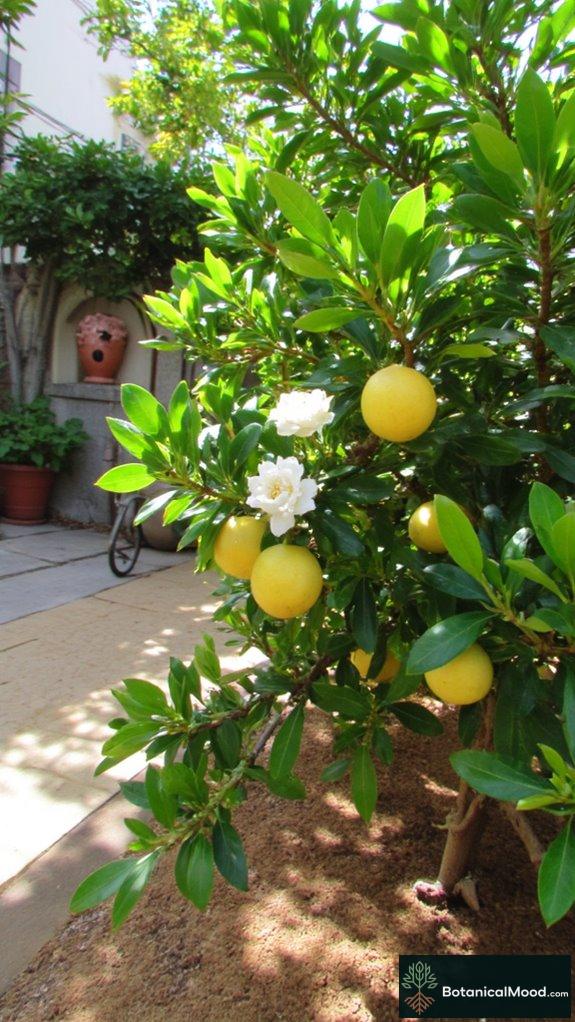
Meyer lemon trees are a stunning addition to any urban garden, offering both visual appeal and delightful citrus flavors.
The beauty of Meyer lemon cultivation lies in its compact size and fragrant blossoms, which attract pollinators and enhance your garden’s ambiance.
These hardy trees thrive in containers, making them perfect for patios or balconies.
Not only do Meyer lemons provide a rich, sweet-tart flavor that elevates culinary creations, but their glossy leaves and vibrant fruit add a splash of color.
Don’t miss the numerous Meyer lemon benefits, like their high vitamin C content, which can refresh and invigorate your kitchen.
Dwarf Cherry Trees
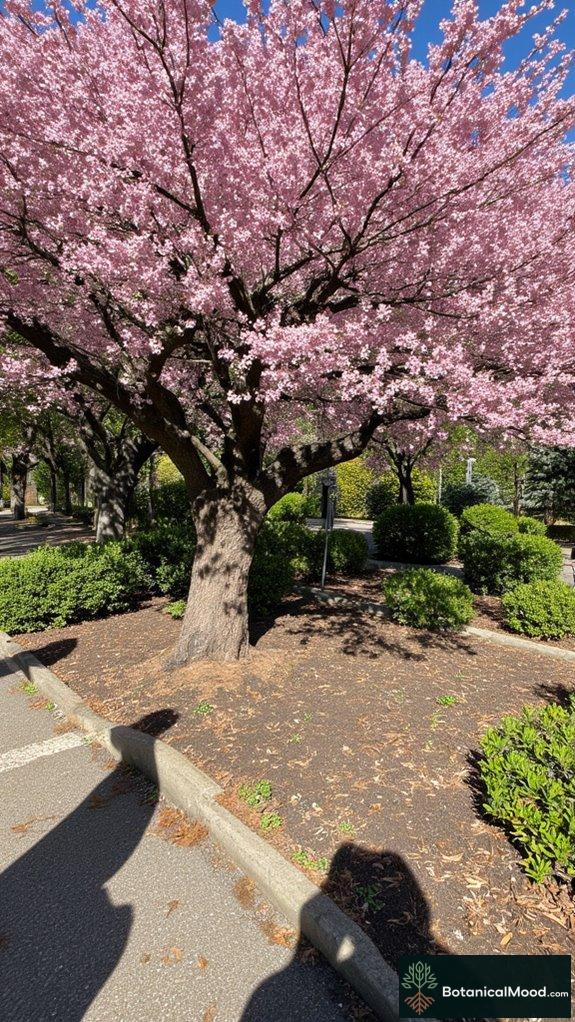
For those looking to infuse their urban gardens with both beauty and bounty, dwarf cherry trees offer a delightful solution. These compact wonders not only produce sweet, succulent fruit, but they also grace your space with stunning blossoms in spring, creating a visual feast.
Dwarf cherry care is minimal yet rewarding; just guarantee they receive full sun and well-drained soil. The cherry tree benefits extend beyond delicious harvests—they attract pollinators and provide shade, enriching your garden’s ecosystem.
As I nurture my own dwarf cherry tree, I cherish its beauty and bounty, truly embodying the essence of compact urban gardening.
Dwarf Peach Trees
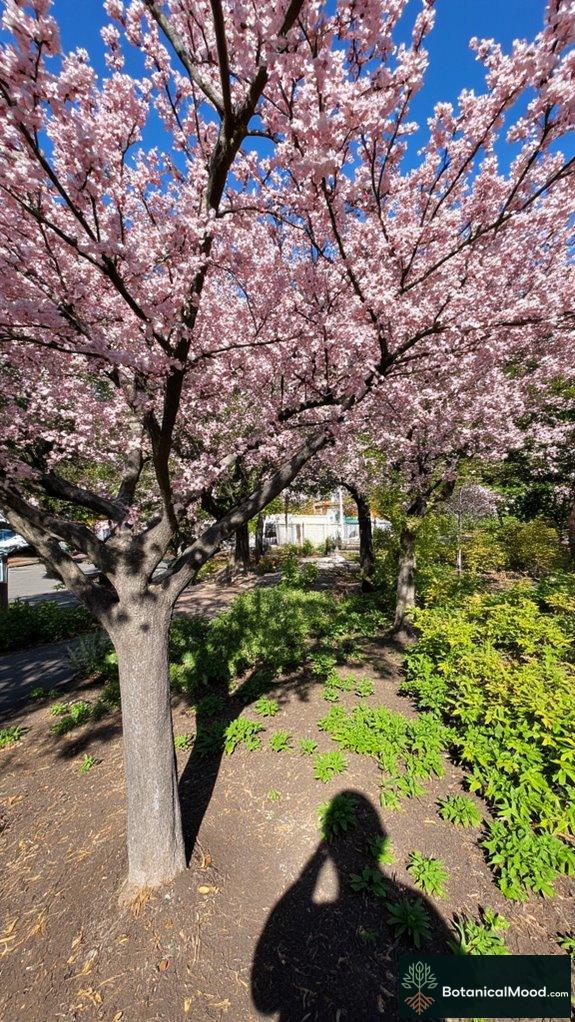
Dwarf peach trees, which flourish brilliantly even in limited spaces, serve as a perfect addition to any urban garden. Their stunning blossoms deliver a vibrant spectacle each spring, inviting bees for pollination.
Keep in mind, you’ll need at least two for best fruit production, as many varieties require cross-pollination to thrive.
Employing specific pruning techniques helps maintain their ideal shape and encourages healthier growth, ensuring you enjoy juicy peaches by summer.
As someone with a passion for compact gardening, I can vouch for their beauty and utility, making them an essential part of my own urban oasis, alongside other delightful fruit trees.
Fig Trees (Dwarf Varieties)

Growing fig trees in a compact urban garden can elevate your outdoor space with their lush green foliage and sweet, juicy fruits that often ripen in late summer.
Dwarf fig varieties, like ‘Little Miss Figgy’ or ‘Petite Negra’, offer a splendid option for small gardens, requiring minimal fig maintenance while rewarding you with vibrant, numerous fruits.
These trees thrive in well-drained soil and need full sun to flourish, ensuring they enchant your garden with a delightful aesthetic. Additionally, incorporating layered tropical designs can enhance the overall visual appeal of your garden space.
Planting them near a sunny patio can create a charming retreat, inviting close friends for delightful summer evenings filled with fresh figs and laughter.
Dwarf Pear Trees
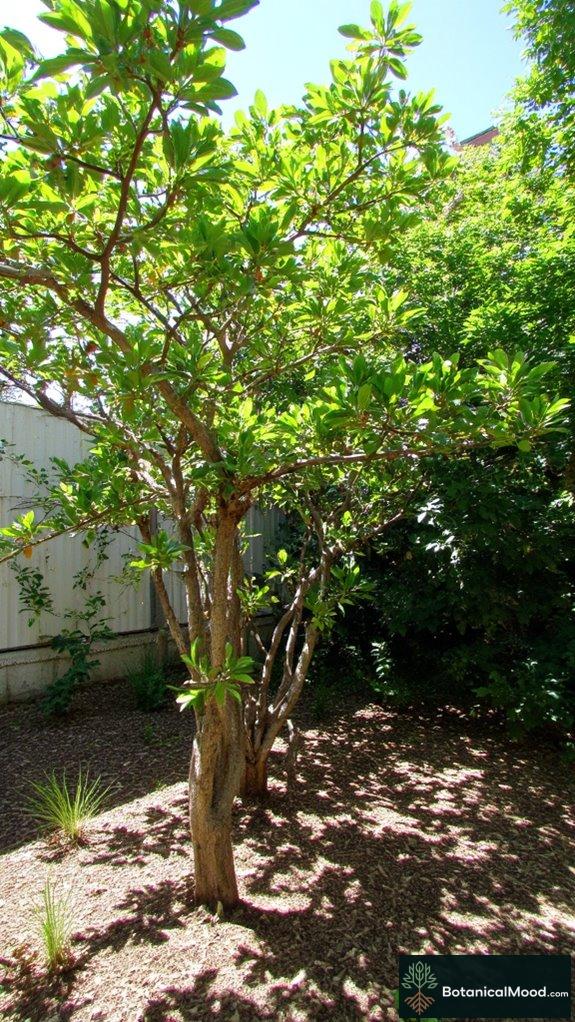
In the heart of an urban garden, pear trees can infuse your space with both elegance and productivity, transforming a simple backyard into a lush, fruitful oasis.
Dwarf pear varieties, like ‘Seckel’ and ‘Bartlett’, are perfect for small spaces, offering both beauty and bountiful harvests.
I’ve found they thrive with the right pruning techniques, allowing for better air circulation and sunlight exposure. A light trimming in late winter keeps them shapely and encourages abundant fruiting.
Just envision plucking juicy pears from a tree that fits neatly in your cozy corner, creating a delightful blend of nature and urban life—all part of the inspiration behind Botanical Mood.
Semi-Dwarf Plum Trees

Semi-dwarf plum trees can elevate any urban garden by offering an incredible blend of aesthetics and functionality, much like their dwarf pear counterparts.
These delightful trees, such as the Santa Rosa and Satsuma plum tree varieties, not only yield juicy fruits but also become stunning focal points with their blossoming flowers in spring.
I love employing urban fruiting techniques, which maximize space and yield in compact areas.
By using trellises or container gardening, you can cultivate these beauties even on a small balcony.
With their vibrant hues and luscious plums, semi-dwarf plums truly enhance our gardens, bringing joy and abundance year-round.
Urban Edible Garden Integration
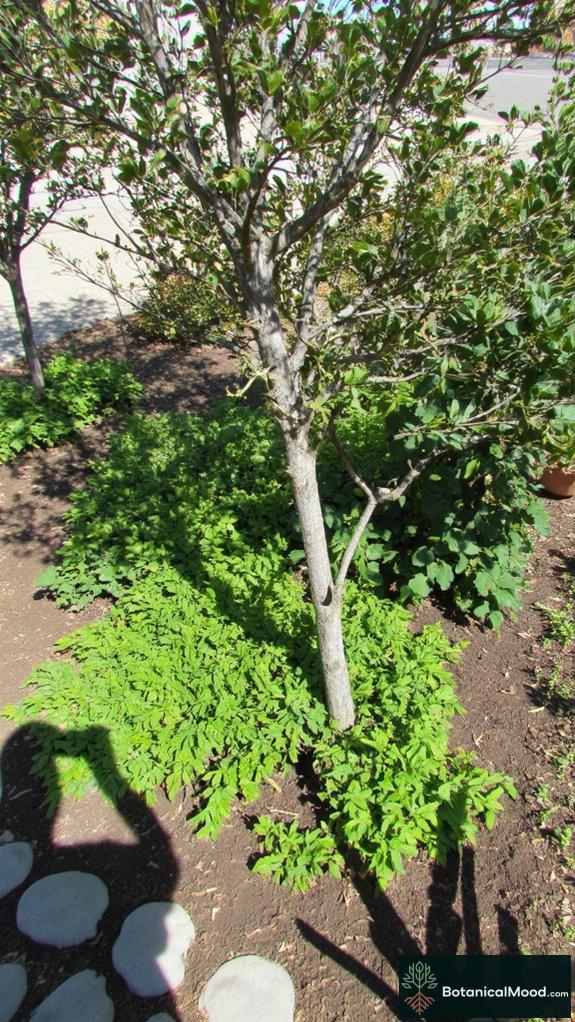
Urban edible gardens not only enhance urban environments but also serve as essential spaces for community engagement and food accessibility. These vibrant green spaces promote sustainable gardening practices, cultivating fresh fruits and vegetables to improve urban nutrition, especially in food deserts where access is limited. Additionally, they can reduce food insecurity, providing communities with greater access to nutritious produce.
Optimal Tree Placement Strategies

Creating a flourishing urban garden requires thoughtful consideration of how fruit trees are strategically placed to optimize yields and space.
When planning your layout, consider these essential strategies:
- Cluster dwarf trees within an 8-foot circle for easy maintenance.
- Employ spacing techniques of 15-20 inches for columnar varieties.
- Orient trees to maximize sunlight exposure while minimizing shade.
- Espalier along fences to efficiently use vertical space.
Meet the Garden’s Creator

Lindsay Carter, a passionate urban gardener from Portland, Oregon, longed for a green sanctuary amidst the city’s concrete chaos, inspiring her to create a compact fruit tree garden that harmonizes with her lifestyle.
Lindsay Carter transformed her urban space into a vibrant fruit tree garden, finding peace amidst Portland’s hustle.
To bring her vision to life, Lindsay initiated a detailed design process, starting with a consultation with a garden creator.
Together, they mapped out the layout, selecting varieties like dwarf apple and fig trees suitable for small spaces, guaranteeing peak sun exposure and ease of care.
With tools like AutoCAD for precise planning and the use of organic compost from Gardener’s Supply Company, Lindsay executed her garden design flawlessly.
She consulted local horticulturists and employed quality products from brands such as Espoma to assure her new garden thrived.
Renowned Landscape Architects and Firms

In the domain of garden design, several renowned terrain architects and firms advocate for the inclusion of compact fruit trees in urban environments, revolutionizing how we perceive and utilize available green spaces.
Designers like Laurie Olin and Thomas Woltz emphasize enhancing scenery aesthetics and encouraging urban biodiversity through dwarf and semi-dwarf fruit trees, fostering sustainability without compromising on beauty.
Firms like SummerWinds Nursery provide ultra-dwarf varieties for patios, while Gwenn Wisniewski’s creations highlight the value of columnar trees in small lots.
Through these ingenious designs, we can create lush, productive havens, harmonizing nature with our urban lives.
FAQ
How Do I Prune Compact Fruit Trees?
Pruning compact fruit trees involves a delicate balance of technique and timing. I focus on removing dead or overcrowded branches, creating an open center for sunlight.
I always prune in late winter or early spring, right before the growing season begins. As I trim, I visualize the tree’s shape, aiming for symmetry and vigor.
This thoughtful approach not only encourages healthy growth but also enhances the beauty of my garden, filling it with life.
Can I Grow These Trees Indoors?
Yes, you can definitely grow compact fruit trees indoors!
For successful indoor gardening, it’s essential to take into account their light requirements. Positioning them near a south or west-facing window guarantees they receive ample sunlight, ideally around 12-16 hours daily.
Don’t forget to rotate the pots occasionally to promote even growth.
I’ve found that varieties like the Dwarf Meyer Lemon thrive beautifully, adding vibrant color and fragrant blossoms to your space while maximizing beauty and productivity.
What Pests Should I Watch for With Urban Fruit Trees?
When growing urban fruit trees, be vigilant for pests like aphids, spider mites, and fruit flies.
Pest identification is essential; catch infestations early to prevent damage.
I’ve found that using organic treatments, such as neem oil or insecticidal soap, works wonders in managing these nuisances without harming the environment.
Keep a close eye on new growth since that’s where many pests love to hide.
A healthy tree leads to beautiful, bountiful fruit!
How Often Should I Fertilize My Compact Fruit Trees?
I usually fertilize my compact fruit trees in spring, applying a balanced fertilizer with micronutrients, like the ones from Jobes or Miracle-Gro.
This helps them thrive as they start their growing season. I follow up with another dose in late summer, ensuring the trees are nourished before winter dormancy.
Always water them after fertilizing to enhance nutrient absorption.
Watching them flourish enriches my gardening journey, which inspired me to create Botanical Mood.
What Are the Best Companion Plants for Urban Fruit Trees?
For companion plants, I love vibrant pollinator plants like lavender and echinacea. They attract essential bees and butterflies, transforming your garden into a lively sanctuary.
Ground cover options, such as creeping thyme or sweet woodruff, enhance your urban scenery with lush greenery, preventing weeds while retaining moisture.
These harmonious choices not only support the health of your fruit trees but also create a stunning tapestry of colors and textures, enriching your garden’s beauty beautifully.
Summary
I’ve found that adding compact fruit trees like dwarf apples and peaches can really elevate my urban garden. They make use of limited space, bring beauty with their blooms, and offer fresh fruit. It feels great to create a little green oasis at home.
I’d love to hear about your experiences with urban gardening! What have you tried, and what worked well for you?
Please share pictures of your garden and tell me how you designed it. I’m eager to see your creative ideas!
References
- https://www.thrivelot.com/resources/5-best-fruit-trees-for-small-urban-gardens
- https://learn.eartheasy.com/guides/compact-fruit-trees-ideal-varieties-for-small-gardens/
- https://resprout.com/small-fruit-trees-for-small-garden-designs-33-ideas/
- https://www.summerwindsnursery.com/ca/inspire/blog/dwarf-fruit-trees/
- https://www.youtube.com/watch?v=TtKlhGJ-t2I
- https://edis.ifas.ufl.edu/publication/FR477
- https://pmc.ncbi.nlm.nih.gov/articles/PMC10260856/
- https://pmc.ncbi.nlm.nih.gov/articles/PMC10196338/
- https://news.umich.edu/study-finds-that-urban-agriculture-must-be-carefully-planned-to-have-climate-benefits/
- https://www.nsf.gov/news/urban-gardens-are-good-ecosystems-humans
- https://abundantminigardens.com/designing-a-fruit-garden/
- https://www.gwenwisniewski.com/garden-inspirations-blog/urban-fruit-gardens-the-pleasures-of-growing-fruit-in-small-spaces
- https://www.youtube.com/watch?v=SEWZcgt4IEs
- https://themicrogardener.com/choosing-fruit-trees-for-small-gardens/
- https://www.youtube.com/watch?v=lS4vQUg4FhQ
- https://www.metrohort.org/jobs/job_detail/garden-designer-62f118c393c492.01107287
- https://mcleodlandscaping.com/what-do-landscape-designers-do/
- https://lejardinetdesigns.com/2015/08/11/the-role-of-a-garden-designer/
- https://www.rhs.org.uk/education-learning/careers-horticulture/garden-designer
- https://www.theenglishgarden.co.uk/gardening-advice/how-to-become-a-garden-designer-with-pollyanna-wilkinson/
- https://www.attainable-sustainable.net/edible-landscaping/
- https://www.learningwithexperts.com/blogs/articles/tree-trends-trees-for-landscape-designers

Leave a Reply